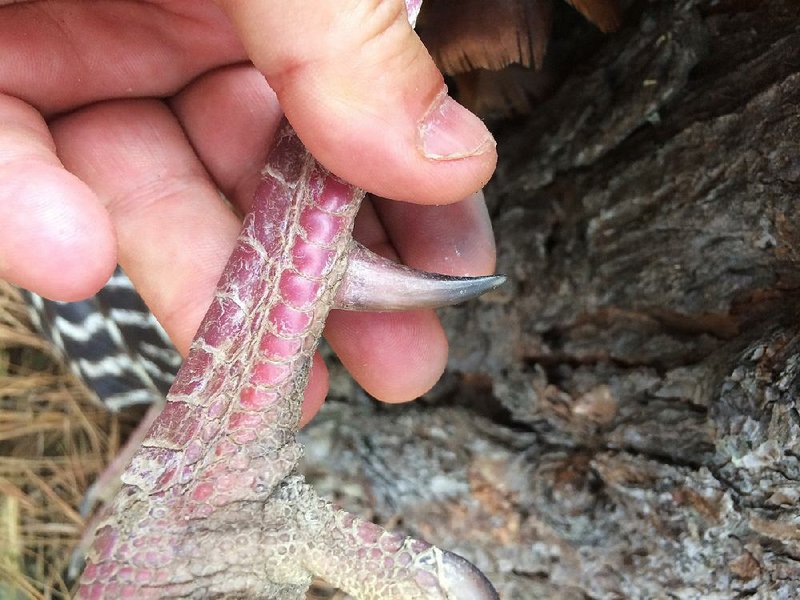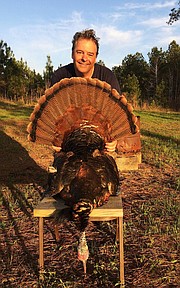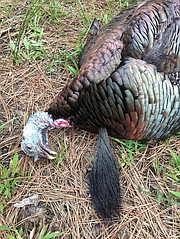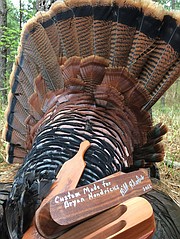A shout out to the crow that saved my turkey hunt Monday.
Opening day of spring turkey season is like opening day of baseball season. Great things are possible, and success can arrive in many packages, as can failure. If not for the crow, my opening day would have ended in disappointment.
Originally, Monday's weather forecast called for rain until about 10 a.m. By Sunday night, the chances of rain diminished. By Monday morning, they all but vanished.
A choir of chuck-wills-widows greeted the dawn, singing soprano over a string section of songbirds. Cardinals joined in as the woods brightened, and I surveyed the pine-studded stage to visualize how the opening act would begin.
Unlike recent years, I did not bring a turkey decoy. For me, decoys have been as much of a liability as an asset early in the season. When a male turkey sees a decoy, he often veers away and expects the "hen" to follow. If he doesn't see a hen, he keeps searching, and he usually comes much closer.
One gobbler sounded between me and a recently thinned pine thicket. Another bellowed to the north, followed by another to the southwest, and yet another. Being roughly between two or more gobblers is advantageous because gobblers will race to a yelping hen.
Instead, these birds all went the other direction.
As usual, I had a selection of calls, including an Eddie Horton (Camden) Arkansas Razorbox. I call it "Corliss" because it is big and has a nasty, raspy tone. I also had an Eddie Horton box call with a bois d'arc base and a cherry lid, as well as a selection of Premium Game Calls (Dierks) diaphragms calls, a Premium Game Calls Aluminum Cutter and a David Taylor (Sheridan) slate/cocobolo pot call.
As usual, I played all of the calls to mimic a flock of hens. Around 8 a.m., a very irate hen arrived on the opposite ridge. She cutt and cackled angrily, and I answered her note for note. I hoped a gobbler would follow, but no.
With my face concealed behind a mask and my eyes concealed behind bronze Oakley sunglasses, the hen topped the ridge and walked 5 yards past me. Oblivious to my presence, she cutt and yelped until she departed.
The same thing happened about 40 minutes later.
Those two hens taught me a lot about vocal sequencing, and I practiced the routine all day.
At 11:30 a.m., the woods settled into their midday routine. A raccoon crossed the fire lane, and crows poked around in the pine duff.
The Rev. Mike Stanley of Highland and I texted all morning about our observations. At 11:30, he said gobblers were probably loafing or dusting in a shady spot, so I packed up and went to town for lunch.
I returned to my spot at 2:20 p.m., which is far later than I like. As I walked, I recalled my last Oklahoma hunt when I bumped into a group of gobblers dusting near my blind about noon. As I neared my set, I saw three jakes on the opposite ridge at the same time they saw me. They scampered in circles and figure-8s like Keystone Cops in a bout of adolescent indecision.
I continued and saw a mature gobbler about 80 yards from where the jakes had been. He left in a hurry. You don't get away with that in Arkansas. If you bust one bird, you've probably buggered that spot for the day, but if you bust four birds, you've probably ruined that spot for a week.
I considered leaving, but with gobblers moving, I didn't want to chance bumping even more birds. Besides, I have killed two gobblers on this property after 3 p.m., so I said a little prayer and asked the Good Lord to send a gobbler back my way. I waited about 30 minutes before I resumed calling.
Before 4 p.m., a gobbler bellowed to the north and left a sound trail that followed a wide arc to the east and then to the southeast. It entered my sector, but it was resolutely going away.
Eventually the gobbler went silent. I assumed it went into a nearby cutover, and that the hunt was finished.
I started to gather my gear when a crow plummeted through the pines and screeched about 75 yards away. A shock gobble thundered in response. That gobbler was close and was drifting my direction.
I deployed my secret weapon: the fighting purr. Stanley taught me the call, and it has closed the deal on several reluctant gobblers. This bird gobbled wildly throughout the sequence, but he seemed to veer away.
It was time for "Corliss" to pound the paint. Big Nasty made a few cutts, cackles and yelps, and that did the trick. The gobbler was coming. I heard him drum and drag his wings, but where would he appear?
The easiest approach was the grassy fire line in front of me, but turkeys don't always follow the easiest route. My options were limited, and the bird was too close for me to shift positions.
After a short wait, I yelped softly on the diaphragm. The bird gobbled from the fire lane, probably no more than 40 yards away.
I shouldered my gun and waited.
After what seemed like a hyperventilating eternity, my heart leaped when I saw the gobbler's bright red head be-bopping behind a brushy curtain. When I saw the beard, I knew he was legal.
At 5:08 p.m., my Winchester SX3 dropped the gavel on this meeting.
I said a prayer of gratitude and stuffed the bird into my vest. I didn't weigh him, but his beard was exactly 11 inches long, my biggest.
I followed the gobbler's path out of the woods and bumped a hen at the far end of the fire lane. That's the only time I've ever called a gobbler away from a live hen.
That made the hunt especially sweet, but I couldn't have done it without the crow.
Sports on 04/14/2019




